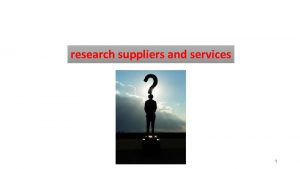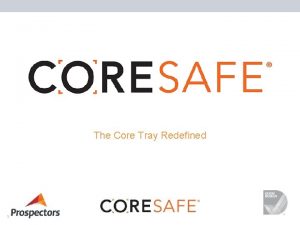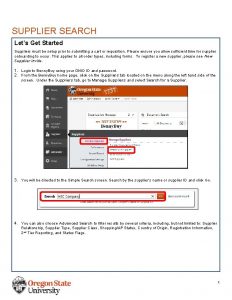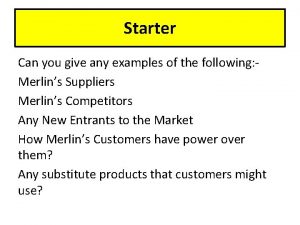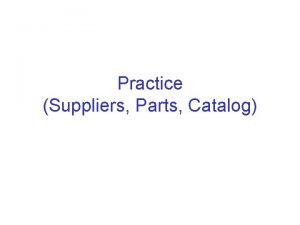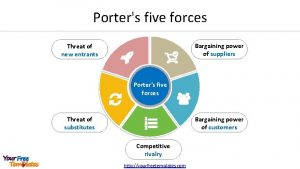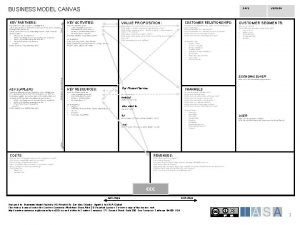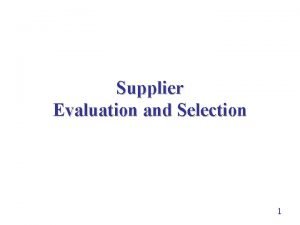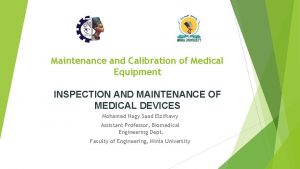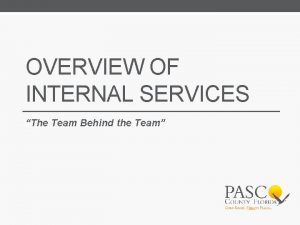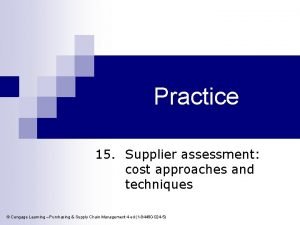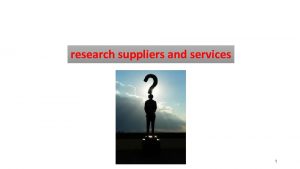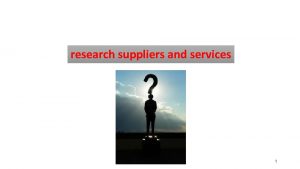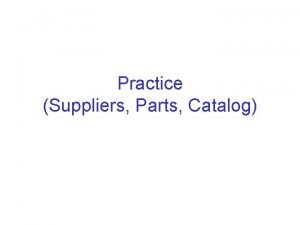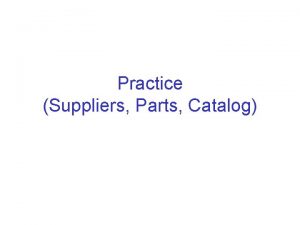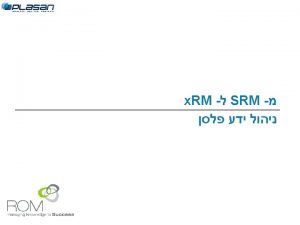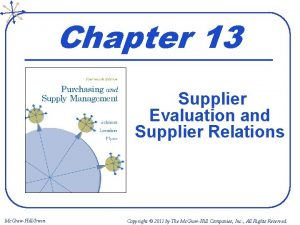research suppliers and services 1 2 Internal supplier



























































- Slides: 59

research suppliers and services 1

2

Internal supplier is a marketing research department or function located within a firm. Many firms, particularly large ones, maintain in-house marketing research departments. A marketing research department’s place in an organisation structure may vary quite considerably. At one extreme, the research function may be centralised and located at the corporate headquarters, allowing the development of a range of skills and expertise to be built up in a team. 3

At the other extreme is a decentralised structure in which the marketing research function is organised along divisional lines, allowing specific and focused expertise to be developed but without the breadth of experience that may lie in a centralised team. In a decentralised scheme, the company may be organised into divisions by products, customers or geographical regions, with marketing research personnel assigned to the various divisions. 4

5

External suppliers are outside firms hired to supply marketing research data. These external suppliers collectively comprise the marketing research industry. These suppliers range from small (one or a few persons) operations to very large global corporations. (kapsamak) 6

7

8

Full-service suppliers offer the entire range of marketing research services, for example defining a problem, developing a research design, conducting focus group interviews, designing questionnaires, sampling, collecting, analyzing and interpreting data, and presenting reports. 9

They may also address the marketing implications of the information they present. The services provided by these suppliers can be further broken down into syndicated services, standardized services and customized services 10

11

Full-service suppliers Syndicated services collect information that they provide to subscribers. Surveys, diary panels, scanners and audits are the main means by which these data are collected. Standardised services are research studies conducted for different clients but in a standard way. For example, procedures for measuring advertising effectiveness have been standardised so that the results can be compared across studies and evaluative norms can be established. Customised services offer a variety of marketing research services specifically designed to suit a client’s particular needs. Each marketing research project is treated uniquely. Internet services offer a combination or variety of secondary data and intelligence gathering, survey or qualitative interviewing, and the analysis and publication of research findings, all through the Internet. 12

13

Limited-service suppliers specialise in one or a few phases of a marketing research project. Services offered by such suppliers are classified as field services, coding and data entry, analytical services, data analysis, and branded products. 14

Field services collect data through mail, personal interviews or telephone interviews, and firms that specialise in interviewing are called field service organisations. These organisations may range from small proprietary organisations that operate locally to large multinationals. Coding and data entry services include editing completed questionnaires, developing a coding scheme, and transcribing the data on to diskettes or magnetic tapes for input into a computer. Analytical services include designing and pretesting questionnaires, determining the best means of collecting data, and designing sampling plans, as well as other aspects of the research design. Data analysis services are offered by firms, that specialise in computer analysis of quantitative data such as those obtained in large surveys. Initially, most data analysis firms supplied only tabulations and cross-tabulations. Now, many firms offer sophisticated data analysis using advanced statistical techniques. Branded marketing research products and services are specialised data collection and analysis procedures developed to address specific types of marketing research problems. These procedures may be patented, given brand names, and marketed like any other branded product. Microscope by Retail Marketing (In-Store) Services is an example of a branded product. 15

Factors Influencing Company Marketing Strategy Marketing intermediaries in Ma fo rk sy rm eti st at ng em io n Demographic/ economic environment Customer Price Relationships g n tio ke za ar ni em M ga yst or s Political/ legal environment Place Promotion Im M pl ar e sy meketi st nt ng em at io n Suppliers Product M pl ark sy ann etin st in g em g Competitors Technical/ physical environment Publics Social/ cultural environment 16

Marketing Mix Research Product Research Price Research Distribution Research Promotion Research 17

Product Research Product research takes many forms and includes studies designed to evaluate and develop new products and to learn how to adapt existing product lines. Concept testing exposes potential customers to a new product idea to judge the acceptance and feasibility of the concept. Brand-name evaluation studies investigate whether a name is appropriate for a product. Package testing assesses size, color, shape, ease of use, and other attributes of a package. 18

Price Research Many test markets address the question of how consumers will respond to a product offering two different prices. Pricing involves finding the amount of monetary sacrifice that best represents the value customers perceive in a product after considering various market constraints (kısıtlamalar). Pricing research also investigates the way people respond to pricing tactics. How do consumers respond to price reductions in one form or another? How much are people willing to pay for some critical product attribute (nitelik)? Do consumers view prices and/ or quantity discounts as fair in a given category? Do price gaps among national brands, regional brands, and private labels exist? 19

Distribution Research Distribution research is symbolized by studies aimed at selecting retail sites or warehouse locations. A survey of retailers or wholesalers may be conducted because the actions of one channel member can greatly affect the performance of other channel members. Distribution research often is needed to gain knowledge about retailers’ and wholesalers’ operations and to learn their reactions to a manufacturer’s marketing policies. It may also be used to examine the effect of just-in-time ordering systems or exclusive distribution on product quality. Research focused on developing and improving the efficiency of marketing channels is extremely important. 20

Promotion Research Promotion research investigates the effectiveness of advertising, premiums, coupons, sampling, discounts, public relations, and other sales promotions. However, among all of these, firms spend more time, money, and effort on advertising research. Media research helps businesses make decisions about whether television, newspapers, magazines, or other media alternatives are best suited to convey the intended message. Choices among media alternatives may be based on research that shows the proportion of consumers in each market segment that a particular advertising vehicle can reach 21

Different Specific Research Topics (A) Business/Economic and Corporate Research 1. industry/market characteristics /consumer profiles 2. acquisition/diversification studies 3. market-share analyses internal employee studies (e. g. , morale) (B) Pricing 5. cost analysis 6. profit analysis 7. price elasticity C) Product 10. concept development and testing 11. brand name generation and testing 12. test markets 13. product testing of existing products 4. 14. packaging design studies 15. competitive product studies (D) Advertising 16. copy testing 17. promotion effectiveness studies 8. demand analysis: market potential sales potential (E) Distribution 18. plant/warehouse location studies 19. channel performance studies sales forecasts 9. competitive pricing analyses 20. channel coverage studies 21. export and international studies 22

International Business Research Process 23

1. Determining research type First Step Preparing stage 2. Defining problem/opportunity 3. Past of the subject 4. Questioning the research 5. Planning of research proposal Second Step Designing the study 6. Choosing research method 7. Selecting sampling method 8. Collecting data 9. Classifying data Implementing Third Step the study 10. Analyzing data 11. findings interpretation 12. preparing report 13. Implementing the suggestions 14. monitoring the results 24

First Step A. Exploratory Research Preparing stage B. Descriptive Research 1. Determining research type C. Causality Research 25

A. Exploratory Research ♦ Conducted for a problem that has not been clearly defined. ♦ It should draw definitive conclusions only with extreme caution. ♦ Perceived problem does not actually exist. Exploratory research often relies on secondary research such as reviewing available literature and/or data, or qualitative approaches such as informal discussions with consumers, employees, management or competitors, and more formal approaches through in-depth interviews, focus groups, projective methods, case studies or pilot studies. ♦ The Internet allows for research methods that are more interactive in nature. For example, RSS feeds efficiently supply researchers with up-todate information; major search engine search results may be sent by email to researchers by services such as Google Alerts. ♦ The results of exploratory research are not usually useful for decisionmaking by themselves, but they can provide significant insight into a given situation. ♦ Exploratory research is not typically generalizable to the population at large. 26

B. Descriptive Research Descriptive research, is used to describe characteristics of a population or phenomenon being studied. It does not answer questions about how/when/why the characteristics occurred. Rather it addresses the "what" question (What are the characteristics of the population or situation being studied? ) The characteristics used to describe the situation or population are usually some kind of categorical scheme also known as descriptive categories. Descriptive research generally precedes (öncesinde gelmek) explanatory research. 27

C. Causality Research Causality (also referred to as causation) is the relation between an event (the cause) and a second event (the effect), where the second event is understood as a consequence of the first. In common usage, causality is also the relation between a set of factors (causes) and a phenomenon (the effect). Anything that affects an effect is a factor of that effect. A direct factor is a factor that affects an effect directly, that is, without any intervening factors. (Intervening(aracı) factors are sometimes called "intermediate factors". ) 28

Examples for Types of Research Designs Uses Exploratory Research Descriptive Research Causal Research • Formulate problems more precisely • Establish priorities for research • Eliminate impractical ideas • Clarify concepts • Develop Hypotheses • Describe segment characteristics • Estimate proportion of people who behave in a certain way • Make specific predictions • Test hypotheses • Provide evidence regarding causal relationships by means of: • Concomitant variation • Time order in which variables occur • Elimination other explanations Types • Literature search • Experience survey • Analysis of select cases • Focus groups • Interviews • Projective tests • Ethnographies • Longitudinal study • True panel • Omnibus panel • Sample Survey • Laboratory experiment • Field experiment 29

30

First Step Preparing stage 2. Defining problem/opportunity The logical starting point in wishing to support the decision-maker is trying to understand what business problem or opportunity is being tackled. (ele alınan) 31

First Step Preparing stage 3. Past of the subject Means literature review. Who did, accepted, proved or rejected what? Searching past of the subject simplify the methodology process. Literature review can be conducted in a library or on Internet. 32

First Step Preparing stage 4. Questioning the research Studies should bring a benefit to the company and contribute to solve a problem or evaluate an opportunity. At this stage, the research must be carried out cost-benefit analysis. If the research cost is more than the benefit comes from the research, it is not necessary to continue the research. 33

Second Step Designing the study 5. Planning research proposal The purpose of any research should be written down. There is no ideal and single format or standard in social researches which includes all the steps of a research. Marketing research plan identifies and thoroughly explains all the steps one by one. Apart from these two issues a plan should include: (1) Research cost and (2) The time table 34

(A) Problem Definition 1. background information 2. decision problem 3. evaluation of alternative research problems 4. research problem(s) to be addressed 5. review: information needed for decision (B) Research Plan: Exploratory / Secondary Research 1. purpose 2. methods 3. results (C) Research Plan: Descriptive Research 1. purpose 2. methods 3. sampling plan 4. data collection forms 5. data collection procedures 6. projected analyses (w/dummy tables for bivariate analyses) 7. expected results 8. limitations (D) Timeframe (E) Cost Estimates Re sea rch De Pro tai pos ls al i n 35

Second Step Designing the study Elementary Data Collected by us 6. Choosing research method Secondary Data Collected by Somebody else 36

37

Second Step Designing the study 7. Selecting sampling method 38

Third Step Implementing the study 8. Collecting data Data collection usually takes place early on in an improvement project, and is often formalised through a data collection plan which often contains the following activity: 1. Pre collection activity — agree on goals, target data, definitions, methods 2. Collection — data collections 3. Present Findings — usually involves some form of sorting[2] analysis and/or presentation. Other main types of collection include census, sample survey, and administrative by-product and each with their respective advantages and disadvantages. A census refers to data collection about everyone or everything in a group or statistical population and has advantages such as accuracy and detail, and disadvantages such as cost and time 39

Third Step Implementing the study 9. Classifying data Data can be classify by using some statistical package programs such as SPSS, SAS, MINITAB. EXCEL also can be used for this purpose. Filtration or verification of data is also a part of data classification. Any mistake in data entering may cause a big analysis problem. 40

Implementing the study Third Step 10. Analyzing data Analysis of data is a process of inspecting, cleaning, transforming, and modeling data with the goal of discovering useful information, suggesting conclusions, and supporting decision making. Data analysis has multiple facets and approaches, encompassing diverse techniques under a variety of names, in different business, science, and social science domains. Some statistical techniques use in analyzing data: - Chi square Regression Correlation Variance Discriminant Cluster Conjoint Multidimensional scaling 41

Third Step Implementing the study 11. findings interpretation Interpretation of the statistical results needs a special ability. Usually the expert who conduct the statistical interprets the findings. The interpretation also should be in harmony and parallel with the goal of the research. 42

Third Step Implementing the study 12. preparing report The entire project should be documented in a written report that addresses the specific research questions identified, describes the approach, research design, data collection and data analysis procedures adopted, and presents the results and major findings. Research findings should be presented in a comprehensible format so that they can be readily used in the decision making process. In addition, an oral presentation to management should be made using tables, figures and graphs to enhance clarity and impact. 43

Third Step Implementing the study 13. Implementing the suggestions Actually the main process ends with the 12. phase. Phase 13. and 14. are feedbacks. Sides who are related to the research will start to implement the suggestions which offered in the final report. 44

Third Step Implementing the study 14. Monitoring the results The executive managers should monitor the result of the research periodically. Otherwise the result of the research could be useless and needless. 45

The limitations of business research 1 Business research does not make decisions. The role of marketing research is not to make decisions. Rather, research replaces impressions or a total lack of knowledge with pertinent(münasip)information. 2 Business research does not guarantee success. Research, at best, can improve the probability of making a correct decision. Anyone who expects to eliminate the possibility of failure by doing research is both unrealistic and likely to be disappointed. The real value of research can be seen over a long period where increasing the percentage of good decisions should be manifested in improved bottomline performance and in the occasional revelation that arises from research. 46

Business Research in the Twenty-First Century un m Re se ar ch m Co n in es s tio ica ob a Gl es gi lo no l. B ch us Te 47

Communication Technologies Virtually (fiilen) everyone is “connected” today. Increasingly, many people are “connected” nearly all the time. Within the lifetime of the typical undergraduate college senior, the way information is exchanged, stored, and gathered has been revolutionized completely. Today, the amount of information formally contained in an entire library can rest easily in a single personal computer. Today, we can exchange information from nearly anywhere in the world to nearly anywhere in the world almost instantly. Internet connections are now wireless, so one doesn’t have to be tethered to a wall to access the World Wide Web. Our mobile phones and handheld data devices can be used not only to converse, but also as a means of communication that can even involve business research data. In many cases, technology also has made it possible to store or collect data for lower costs than in the past. Electronic communications are usually less costly than regular mail—and certainly less costly than a face-to-face interview—and cost about the same amount no matter how far away a respondent is from a researcher. 48

Global Business Research Like all business activities, business research has become increasingly global as more and more firms operate with few, if any, geographic boundaries. Some companies have extensive international research operations. Upjohn conducts research in 160 different countries. ACNielsen International, known for its television ratings, is the world’s largest research company. Two-thirds of its business comes from outside the United States. 12 Starbucks can now be found in nearly every developed country on the earth Companies that conduct business in foreign countries must understand the nature of those particular markets and judge whether they require customized business strategies. For example, although the fifteen nations of the European Union share a single formal market, research shows that Europeans do not share identical tastes for many consumer products. 49

International Business Research & Ethics Conducting business researches according to ethical cods, which are cumulated over time and suggested by marketing reserchers. 50

Ethical Codes in Business Researches 1. Honesty Strive(gayret etmek)for honesty in all scientific communications. Honestly report data, results, methods and procedures, and publication status. Do not fabricate, falsify(tahrif etmek), or misrepresent data. Do not deceive(kandirmak)colleagues, granting agencies, or the public. * Adapted from Shamoo A and Resnik D. 2009. Responsible Conduct of Research, 2 nd ed. (New York: Oxford University Press). 51

Ethical Codes in Business Researches (Continue) 2. Objectivity Strive to avoid bias in experimental design, data analysis, data interpretation, personnel decisions, expert testimony(Şahitlik), and other aspects of research where objectivity is expected or required. Avoid or minimize bias or self-deception(kandırma). Disclose(ifşa etmek) personal or financial interests that may affect research. 52

Ethical Codes in Business Researches (Continue) 3. Integrity(dürüstlük) Keep your promises and agreements; act with sincerity; strive for consistency (tutarlılık) of thought and action. 4. Carefulness Avoid careless errors and negligence; carefully and critically examine your own work and the work of your peers (ekip). Keep good records of research activities, such as data collection, research design, and correspondence (yazışma) with agencies or journals 53

Ethical Codes in Business Researches (Continue) 5. Openness Share data, results, ideas, tools, resources. Be open to criticism and new ideas. 6. Respect for Intellectual Property (Fikri Mülkiyet) Honor patents, copyrights, and other forms of intellectual property. Do not use unpublished data, methods, or results without permission. Give credit where credit is due. Give proper acknowledgement or credit for all contributions to research. Never plagiarize (intihal yapmak) 54

Ethical Codes in Business Researches (Continue) 7. Confidentiality (Gizlilik) Protect confidential communications, such as papers or grants submitted for publication, personnel records, trade or military secrets, and patient records. 8. Responsible Publication Publish in order to advance research and scholarship, not to advance just your own career. Avoid wasteful and duplicative publication. 9. Responsible Mentoring Help to educate and advise students. Promote their welfare (refah) and allow them to make their own decisions. 55

Ethical Codes in Business Researches (Continue) 10. Respect for colleagues Respect your colleagues and treat them fairly. 11. Social Responsibility Strive to promote social good and prevent through research, public education, and advocacy. 12. Non-Discrimination Avoid discrimination against colleagues or students on the basis of sex, race, ethnicity, or other factors that are not related to their scientific competence and integrity. 56

Ethical Codes in Business Researches (Continue) 13. Competence (Yeterlik) Maintain and improve your own professional competence and expertise through lifelong education and learning; take steps to promote competence in science as a whole. 14. Legality Know and obey relevant laws and institutional and governmental policies. 57

Ethical Codes in Business Researches (Continue) 15. Animal Care Show proper respect and care for animals when using them in research. Do not conduct unnecessary or poorly designed animal experiments. 16. Human Subjects Protection When conducting research on human subjects, minimize harms and risks and maximize benefits; respect human dignity (haysiyet), privacy, and autonomy; and strive to distribute the benefits of research fairly (dürüstçe). 58

Reasons for Conducting Ethical Researches 1. Unethical research is morally wrong: Unethical research may not be illegal, but at least it is not the right thing to do. 2. Unethical research can affect the image of the firm and management. 3. Unethical research can lead to poor-quality data and, ultimately to poor decision 4. New, potentially damaging ethical challenges are being created because of the explosive growth of technological capabilities in the research arena. 59
 Research suppliers meaning
Research suppliers meaning Vddf
Vddf Internal control principles
Internal control principles Vouching in auditing
Vouching in auditing Allergen checklist for food suppliers and manufacturers
Allergen checklist for food suppliers and manufacturers Plastic core tray
Plastic core tray Business model canvas
Business model canvas 5 suppliers criteria
5 suppliers criteria Merlin entertainments suppliers
Merlin entertainments suppliers Suppliers(sid sname address)
Suppliers(sid sname address) Bargaining power of suppliers
Bargaining power of suppliers Northrop grumman
Northrop grumman Boeing supplier portal
Boeing supplier portal Health and safety injection moulding
Health and safety injection moulding Screw type oil -free nitrogen supercharger suppliers
Screw type oil -free nitrogen supercharger suppliers Cheap floating head heat exchanger
Cheap floating head heat exchanger Key club logo
Key club logo What must be done after receiving a key drop delivery?
What must be done after receiving a key drop delivery? Key activities business model
Key activities business model Towing a frame suppliers
Towing a frame suppliers Renault suppliers portal
Renault suppliers portal Key supplier evaluation criteria
Key supplier evaluation criteria General receiving principles
General receiving principles Hospital equipments suppliers
Hospital equipments suppliers Tourism service providers
Tourism service providers Wafer back thinning suppliers
Wafer back thinning suppliers Boar dummy supplier
Boar dummy supplier Seismic cable clamps supplier
Seismic cable clamps supplier Lost wax process manufacturer
Lost wax process manufacturer Medical equipment suppliers association
Medical equipment suppliers association First robotics kit
First robotics kit Fedrigoni freelife cento
Fedrigoni freelife cento Single wall corrugated pipe extruder machine
Single wall corrugated pipe extruder machine Mixed asphalt shingle suppliers
Mixed asphalt shingle suppliers Suppliers objectives
Suppliers objectives Channel levels in marketing
Channel levels in marketing Who are the demanders of loanable funds
Who are the demanders of loanable funds Invoiceless purchasing
Invoiceless purchasing Swap internal audit services
Swap internal audit services Immigration lawyer aifft
Immigration lawyer aifft Miami dade county internal services department
Miami dade county internal services department Internal auditing assurance & advisory services
Internal auditing assurance & advisory services Credit union internal auditing services
Credit union internal auditing services General contractor & supplier
General contractor & supplier Supplier and distributor benchmarking
Supplier and distributor benchmarking Supplier onboarding and integration
Supplier onboarding and integration Vendor rating techniques
Vendor rating techniques Diffserv vs intserv
Diffserv vs intserv Wake county human services community services center
Wake county human services community services center Definition of scope in research
Definition of scope in research Contrast applied research and basic research
Contrast applied research and basic research Operational thought
Operational thought Examples of applied research
Examples of applied research Conclusive research design meaning
Conclusive research design meaning What is inquiry in practical research 2
What is inquiry in practical research 2 The meaning of
The meaning of Srs tamu
Srs tamu Syndicated services in marketing research
Syndicated services in marketing research Research services oxford
Research services oxford Research compliance services
Research compliance services
